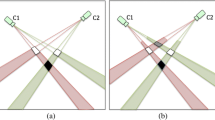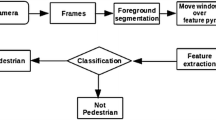Abstract
For the robust detection of pedestrians in intelligent video surveillance, an approach to multi-view and multi-plane data fusion is proposed. Through the estimated homography, foreground regions are projected from multiple camera views to a reference view. To identify false-positive detections caused by foreground intersections of non-corresponding objects, the homographic transformations for a set of parallel planes, which are from the head plane to the ground, are applied. Multiple features including occupancy information and colour cues are extracted from such planes for joint decision-making. Experimental results on real world sequences have demonstrated the good performance of the proposed approach in pedestrian detection for intelligent visual surveillance.











Similar content being viewed by others
References
Berclaz, J., Fleuret, F., Turetken, E., & Fua, P. (2011). Multiple object tracking using k-shortest paths optimization. IEEE Transactions on Pattern Analysis and Machine Intelligence, 33(9), 1806–1819.
Black, J., & Ellis, T. (2006). Multi camera image tracking. Image and Vision Computing, 24(11), 1256–1267.
Cai, Q., & Aggarwal, J. K. (1998). Automatic tracking of human motion in indoor scenes across multiple synchronized video streams. In Sixth international conference on computer vision, 1998. (pp. 356–362). IEEE.
Criminisi, A., Reid, I., & Zisserman, A. (2000). Single view metrology. International Journal of Computer Vision, 40(2), 123–148.
Douglas, D. H., & Peucker, T. K. (1973). Algorithms for the reduction of the number of points required to represent a digitized line or its caricature. Cartographica: The International Journal for Geographic Information and Geovisualization, 10(2), 112–122.
Du, W., & Piater, J. (2007). Multi-camera people tracking by collaborative particle filters and principal axis-based integration. Computer vision-ACCV (pp. 365–374). Springer.
Eshel, R., & Moses, Y. (2010). Tracking in a dense crowd using multiple cameras. International Journal of Computer Vision, 88(1), 129–143.
Hu, W., Hu, M., Zhou, X., Tan, T., Lou, J., & Maybank, S. (2006). Principal axis based correspondence between multiple cameras for people tracking. IEEE Transactions on Pattern Analysis and Machine Intelligence, 28(4), 663–671.
Javed, O., Khan, S., Rasheed, Z. & Shah, M. (2000). Camera handoff: Tracking in multiple uncalibrated stationary cameras. In Proceedings of workshop on human motion, 2000 (pp. 113–118). IEEE.
Kang, J., Cohen, I., & Medioni, G. (2003). Continuous tracking within and across camera streams. Proceedings of the IEEE conference on computer vision and pattern recognition, (Vol. 1, pp. 267–272).
Kettnaker, V. & Zabih, R. (1999). Bayesian multi-camera surveillance. In IEEE computer society conference on computer vision and pattern recognition, 1999 (Vol. 2). IEEE.
Khan, S., & Shah, M. (2003). Consistent labeling of tracked objects in multiple cameras with overlapping fields of view. IEEE Transactions on Pattern Analysis and Machine Intelligence, 25(10), 1355–1360.
Khan, S. M., & Shah, M. (2009). Tracking multiple occluding people by localizing on multiple scene planes. IEEE Transactions on Pattern Analysis and Machine Intelligence, 31(3), 505–519.
Khan, S. M., Yan, P. & Shah, M. (2007). A homographic framework for the fusion of multi-view silhouettes. In IEEE 11th international conference on computer vision (ICCV’2007), 2007 (pp. 1–8). IEEE.
Mittal, A. & Davis, L. (2001). Unified multi-camera detection and tracking using region-matching. In Proceedings of 2001 IEEE workshop on multi-object tracking, 2001 (pp. 3–10). IEEE.
Mittal, A. & Davis, L. S. (2002). M2tracker: A multi-view approach to segmenting and tracking people in a cluttered scene using region-based stereo. In Proceedings of the European conference on computer vision, (pp. 18–33).
Quaritsch, M., Kreuzthaler, M., Rinner, B., Bischof, H., & Strobl, B. (2007). Autonomous multicamera tracking on embedded smart cameras. EURASIP Journal on Embedded Systems, 2007(1), 35–35.
Ren, J., Xu, M., & Smith, J. S. (2015). Multi-view pedestrian detection using occupancy color matching. In Proceedings of the 1st IEEE conference on multimedia big data.
Stauffer, C., & Grimson, W. E. L. (1999). Adaptive background mixture models for real-time tracking. In IEEE computer society conference on computer vision and pattern recognition, 1999 (Vol. 2). IEEE.
Stein, G. P. (1999). Tracking from multiple view points: Self-calibration of space and time. In Proceedings of the IEEE conference on computer vision and pattern recognition.
Wright, J., Wagner, A., Rao, S. & Ma, Y. (2006). Homography from coplanar ellipses with application to forensic blood splatter reconstruction. In Proceedings of the IEEE conference on computer vision and pattern recognition (pp. 1250–1257).
Xu, M., Orwell, J., Lowey, L., & Thirde, D. (2005). Architecture and algorithms for tracking football players with multiple cameras. IEE Proceedings-Vision, Image and Signal Processing, 152(2), 232–241.
Xu, M., Ren, J., Chen, D., Smith, J. S., Liu, Z., & Jia, T. (2012). Robust object detection with real-time fusion of multiview foreground silhouettes. Optical Engineering, 51(4), 047202.
Xu, M., Ren, J., Chen, D., Smith, J. & Wang, G. (2011). Real-time detection via homography mapping of foreground polygons from multiple cameras. In 18th IEEE international conference on image processing (ICIP), 2011 (pp. 3593–3596. IEEE.
Zeng, H., Deng, X., & Hu, Z. (2008). A new normalized method on line-based homography estimation. Pattern Recognition Letters, 29, 1236–1244.
Acknowledgments
This work was supported by the National Natural Science Foundation of China (NSFC) under Grant 60975082 and the Scientific Research Program funded by Shaanxi Provincial Education Department, P. R. China, under Grant 15JK1310.
Author information
Authors and Affiliations
Corresponding author
Rights and permissions
About this article
Cite this article
Ren, J., Xu, M., Smith, J.S. et al. Multi-view and multi-plane data fusion for effective pedestrian detection in intelligent visual surveillance. Multidim Syst Sign Process 27, 1007–1029 (2016). https://doi.org/10.1007/s11045-016-0428-x
Received:
Revised:
Accepted:
Published:
Issue Date:
DOI: https://doi.org/10.1007/s11045-016-0428-x




